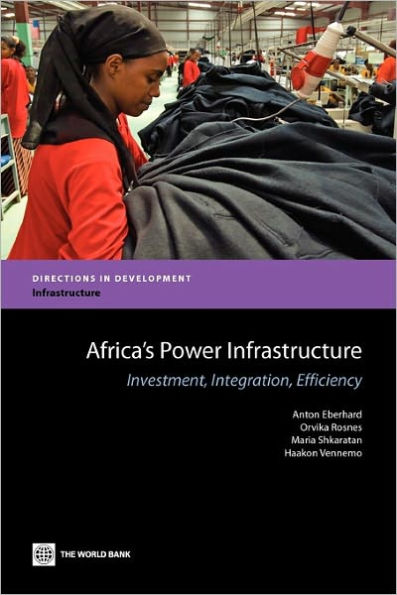Africa's Power Infrastructure: Investment, Integration, Efficiency available in Paperback, eBook

Africa's Power Infrastructure: Investment, Integration, Efficiency
- ISBN-10:
- 0821384554
- ISBN-13:
- 9780821384558
- Pub. Date:
- 04/11/2011
- Publisher:
- World Bank Publications
- ISBN-10:
- 0821384554
- ISBN-13:
- 9780821384558
- Pub. Date:
- 04/11/2011
- Publisher:
- World Bank Publications

Africa's Power Infrastructure: Investment, Integration, Efficiency
Buy New
$30.00Overview

Product Details
| ISBN-13: | 9780821384558 |
|---|---|
| Publisher: | World Bank Publications |
| Publication date: | 04/11/2011 |
| Series: | Directions in Development - Infrastructure |
| Pages: | 348 |
| Product dimensions: | 6.00(w) x 9.00(h) x 0.80(d) |
Table of Contents
About the AICD xvii
Series Foreword xix
Acknowledgments xxi
Abbreviations xxvii
Chapter 1 Africa Unplugged 1
The Region's Underdeveloped Energy Resources 1
The Lag in Installed Generation Capacity 2
Stagnant and Inequitable Access to Electricity Services 5
Unreliable Electricity Supply 7
The Prevalence of Backup Generators 7
Increasing Use of Leased Emergency Power 10
A Power Crisis Exacerbated by Drought, Conflict, and High Oil Prices 12
High Power Prices That Generally Do Not Cover Costs 12
Deficient Power Infrastructure Constrains Social and Economic Development 16
Notes 19
References 19
Chapter 2 The Promise of Regional Power Trade 23
Uneven Distribution and Poor Economies of Scale 24
Despite Power Pools, Low Regional Power Trade 26
The Potential Benefits of Expanded Regional Power Trading 28
What Regional Patterns of Trade Would Emerge? 31
Water Resources Management and Hydropower Development 33
Who Gains Most from Power Trade? 33
How Will Less Hydropower Development Influence Trade Flows? 38
What Are the Environmental Impacts of Trading Power? 39
Technology Choices and the Clean Development Mechanism 39
How Might Climate Change Affect Power Investment Patterns? 40
Meeting the Challenges of Regional Integration of Infrastructure 40
Conclusion 50
Note 50
Bibliography 50
Chapter 3 Investment Requirements 53
Modeling Investment Needs 54
Estimating Supply Needs 55
Overall Cost Requirements 58
The SAPP 64
The EAPP/Nile Basin 67
WAPP 70
CAPP 74
Notes 77
Reference 78
Chapter 4 Strengthening Sector Reform and Planning 79
Power Sector Reform in Sub-Saharan Africa 80
Private Management Contracts: Winning the Battle, Losing the War 85
Sector Reform, Sector Performance 87
The Search for Effective Hybrid Markets 88
The Possible Need to Redesign Regulatory Institutions 94
Notes 100
Bibliography 101
Chapter 5 Widening Connectivity and Reducing Inequality 103
Low Electricity Connection Rates 104
Mixed Progress, despite Many Agencies and Funds 105
Inequitable Access to Electricity 110
Affordability of Electricity-Subsidizing the Well-Off 112
Policy Challenges for Accelerating Service Expansion 119
References 129
Chapter 6 Recommitting to the Reform of State-Owned Enterprises 133
Hidden Costs in Underperforming State-Owned Enterprises 134
Driving Down Operational Inefficiencies and Hidden Costs 135
Effect of Better Governance on Performance of State-Owned Utilities 136
Making State-Owned Enterprises More Effective 137
Conclusion 147
References 148
Chapter 7 Closing Africa's Power Funding Gap 149
Existing Spending in the Power Sector 151
How Much More Can Be Done within the Existing Resource Envelope? 157
Increasing Cost Recovery 158
On Budget Spending: Raising Capital Budget Execution 160
Improving Utility Performance 161
Savings from Efficiency-Oriented Reforms 162
Annual Funding Gap 164
How Much Additional Finance Can Be Raised? 166
Costs of Capital from Different Sources 178
The Most Promising Ways to Increase Funds 180
What Else Can Be Done? 180
Taking More Time 180
Lowering Costs through Regional Integration 181
The Way Forward 182
Note 183
References 183
Appendix 1 Africa Unplugged 187
Appendix 2 The Promise of Regional Power Trade 199
Appendix 3 Investment Requirements 213
Appendix 4 Strengthening Sector Reform and Planning 239
Appendix 5 Widening Connectivity and Reducing Inequality 267
Appendix 6 Recommitting to the Reform of State-Owned Enterprises 291
Appendix 7 Closing Africa's Power Funding Gap 299
Index 305
Boxes
2.1 The Difficulties in Forging Political Consensus: The Case of Westcor 42
2.2 The West African Power Pool (WAPP) and New Investment 45
2.3 Difficulties in Setting Priorities in SAPP 46
3.1 Definitions 61
4.1 Kenya's Success with Private Sector Participation in Power 83
4.2 Cote d'Ivoire's Independent Power Projects Survive Civil War 84
4.3 Power Sector Planning Dilemmas in South Africa 90
5.1 Ghana's Electrification Program 106
5.2 Residential Electricity Tariff Structures in Sub-Saharan Africa 116
